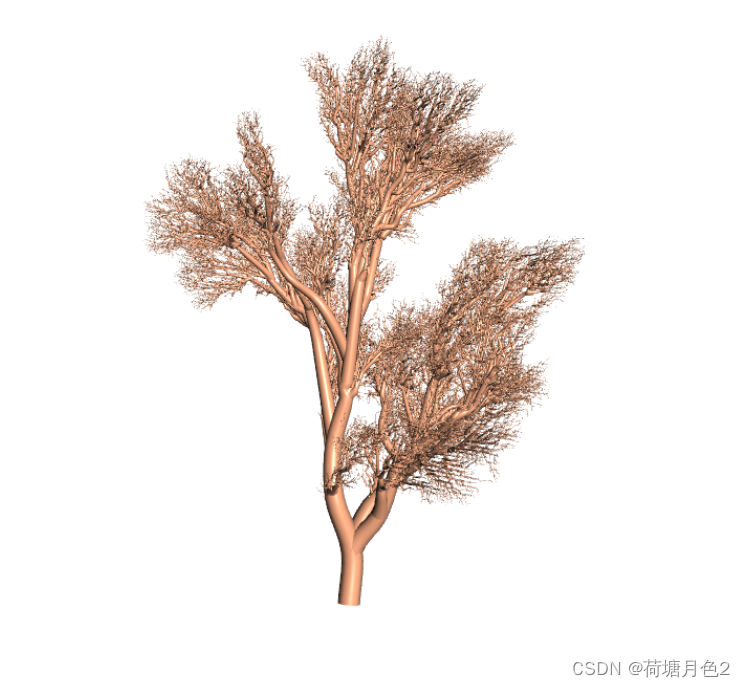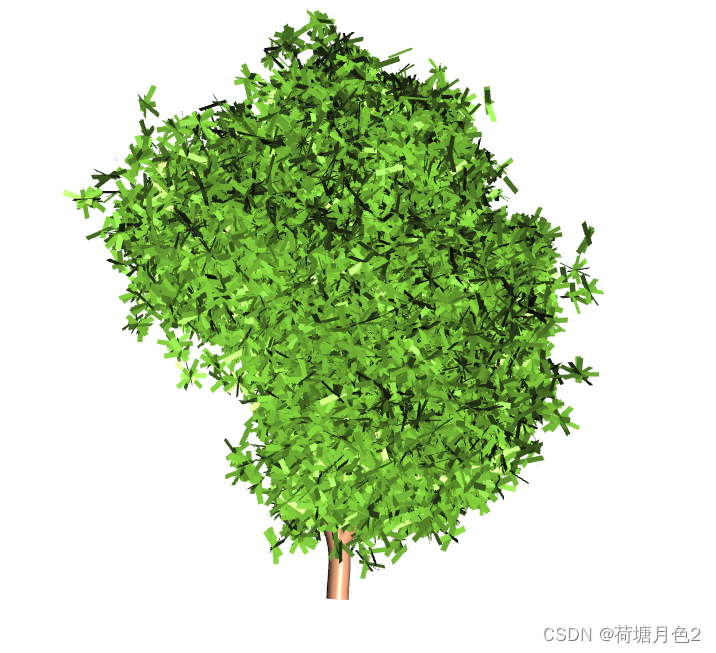Selected program examples include c++ pcl point cloud transformation, skeleton branches, adding leaf source code examples. If you need to install a running environment or remote debugging, please see your personal QQ business card at the bottom of the article for remote assistance from professional technicians!
Preface
This blog writes code for "C++ pcl point cloud transformation skeleton branch adding leaf source code example". The code is clean, regular and easy to read. Recommended for learning and application.
operation result

 ***
***
Article directory
1. Required tools and software
2. Usage steps
1. Main code
2. Operation results
3. Online assistance
1. Required tools and software
1. VS2019, Qt
2. C++
2. Usage steps
The code is as follows (example):
/*
* Copyright (C) 2019 by
* Shenglan Du ([email protected])
* Liangliang Nan ([email protected])
* 3D Geoinformation, TU Delft, https://3d.bk.tudelft.nl
*
* This file is part of AdTree, which implements the 3D tree
* reconstruction method described in the following paper:
* -------------------------------------------------------------------------------------
* Shenglan Du, Roderik Lindenbergh, Hugo Ledoux, Jantien Stoter, and Liangliang Nan.
* AdTree: Accurate, Detailed, and Automatic Modeling of Laser-Scanned Trees.
* Remote Sensing. 2019, 11(18), 2074.
* -------------------------------------------------------------------------------------
* Please consider citing the above paper if you use the code/program (or part of it).
*
* AdTree is free software; you can redistribute it and/or modify
* it under the terms of the GNU General Public License Version 3
* as published by the Free Software Foundation.
*
* AdTree is distributed in the hope that it will be useful,
* but WITHOUT ANY WARRANTY; without even the implied warranty of
* MERCHANTABILITY or FITNESS FOR A PARTICULAR PURPOSE. See the
* GNU General Public License for more details.
*
* You should have received a copy of the GNU General Public License
* along with this program. If not, see <http://www.gnu.org/licenses/>.
*/
// save the smoothed skeleton into a PLY file (where each vertex has a radius)
void save_skeleton(Skeleton* skeleton, PointCloud* cloud, const std::string& file_name) {
const ::Graph& sgraph = skeleton->get_smoothed_skeleton();
if (boost::num_edges(sgraph) == 0) {
std::cerr << "failed to save skeleton (no edge exists)" << std::endl;
return;
}
// convert the boost graph to Graph (avoid modifying easy3d's GraphIO, or writing IO for boost graph)
std::unordered_map<SGraphVertexDescriptor, easy3d::Graph::Vertex> vvmap;
easy3d::Graph g;
auto vertexRadius = g.add_vertex_property<float>("v:radius");
auto vts = boost::vertices(sgraph);
for (SGraphVertexIterator iter = vts.first; iter != vts.second; ++iter) {
SGraphVertexDescriptor vd = *iter;
if (boost::degree(vd, sgraph) != 0) {
// ignore isolated vertices
const vec3& vp = sgraph[vd].cVert;
auto v = g.add_vertex(vp);
vertexRadius[v] = sgraph[vd].radius;
vvmap[vd] = v;
}
}
auto egs = boost::edges(sgraph);
for (SGraphEdgeIterator iter = egs.first; iter != egs.second; ++iter) {
SGraphEdgeDescriptor ed = *iter; // the edge descriptor
SGraphEdgeProp ep = sgraph[ed]; // the edge property
SGraphVertexDescriptor s = boost::source(*iter, sgraph);
SGraphVertexDescriptor t = boost::target(*iter, sgraph);
g.add_edge(vvmap[s], vvmap[t]);
}
auto offset = cloud->get_model_property<dvec3>("translation");
if (offset) {
auto prop = g.model_property<dvec3>("translation");
prop[0] = offset[0];
}
if (GraphIO::save(file_name, &g))
std::cout << "model of skeletons saved to: " << file_name << std::endl;
else
std::cerr << "failed to save the model of skeletons into file" << std::endl;
}
// returns the number of processed input files.
int batch_reconstruct(std::vector<std::string>& point_cloud_files, const std::string& output_folder, bool export_skeleton) {
int count(0);
for (std::size_t i=0; i<point_cloud_files.size(); ++i) {
const std::string& xyz_file = point_cloud_files[i];
std::cout << "------------- " << i + 1 << "/" << point_cloud_files.size() << " -------------" << std::endl;
std::cout << "processing xyz_file: " << xyz_file << std::endl;
if (!file_system::is_directory(output_folder)) {
if (file_system::create_directory(output_folder))
std::cout << "created output directory '" << output_folder << "'" << std::endl;
else {
std::cerr << "failed creating output directory" << std::endl;
return 0;
}
}
// load point_cloud
PointCloud *cloud = PointCloudIO::load(xyz_file);
if (cloud) {
std::cout << "cloud loaded. num points: " << cloud->n_vertices() << std::endl;
// compute bbox
Box3 box;
auto points = cloud->get_vertex_property<vec3>("v:point");
for (auto v : cloud->vertices())
box.add_point(points[v]);
// remove duplicated points
const float threshold = box.diagonal() * 0.001f;
const auto &points_to_remove = RemoveDuplication::apply(cloud, threshold);
for (auto v : points_to_remove)
cloud->delete_vertex(v);
cloud->garbage_collection();
std::cout << "removed too-close points. num points: " << cloud->n_vertices() << std::endl;
}
else {
std::cerr << "failed to load point cloud from '" << xyz_file << "'" << std::endl;
continue;
}
// reconstruct branches
SurfaceMesh *mesh = new SurfaceMesh;
const std::string &branch_filename = file_system::base_name(cloud->name()) + "_branches.obj";
mesh->set_name(branch_filename);
Skeleton *skeleton = new Skeleton();
bool status = skeleton->reconstruct_branches(cloud, mesh);
if (!status) {
std::cerr << "failed in reconstructing branches" << std::endl;
delete cloud;
delete mesh;
delete skeleton;
continue;
}
// copy translation property from point_cloud to surface_mesh
SurfaceMesh::ModelProperty<dvec3> prop = mesh->add_model_property<dvec3>("translation");
prop[0] = cloud->get_model_property<dvec3>("translation")[0];
// save branches model
const std::string branch_file = output_folder + "/" + branch_filename;
if (SurfaceMeshIO::save(branch_file, mesh)) {
std::cout << "model of branches saved to: " << branch_file << std::endl;
++count;
}
else
std::cerr << "failed to save the model of branches" << std::endl;
if (export_skeleton) {
const std::string& skeleton_file = output_folder + "/" + file_system::base_name(cloud->name()) + "_skeleton.ply";
save_skeleton(skeleton, cloud, skeleton_file);
}
delete cloud;
delete mesh;
delete skeleton;
}
return count;
}
int main(int argc, char *argv[]) {
// argc = 2;
// argv[1] = "/Users/lnan/Projects/adtree/data";
// argv[2] = "/Users/lnan/Projects/adtree/data-results";
if (argc == 1) {
TreeViewer viewer;
viewer.run();
return EXIT_SUCCESS;
} else if (argc >= 3) {
bool export_skeleton = false;
for (int i = 0; i < argc; ++i) {
if (strcmp(argv[i], "-s") == 0 || strcmp(argv[i], "-skeleton") == 0) {
export_skeleton = true;
break;
}
}
if (export_skeleton) {
std::cout << "You have requested to save the reconstructed tree skeleton(s) in PLY format into the output directory." << std::endl;
std::cout << "The skeleton file(s) can be visualized using Easy3D: https://github.com/LiangliangNan/Easy3D" << std::endl;
}
else
std::cout << "Tree skeleton(s) will not be saved (append '-s' or '-skeleton' in commandline to enable it)" << std::endl;
std::string first_arg(argv[1]);
std::string second_arg(argv[2]);
if (file_system::is_file(second_arg))
std::cerr << "WARNING: second argument cannot be an existing file (expecting a directory)." << std::endl;
else {
std::string output_dir = second_arg;
if (file_system::is_file(first_arg)) {
std::vector<std::string> cloud_files = {
first_arg};
return batch_reconstruct(cloud_files, output_dir, export_skeleton) > 0;
} else if (file_system::is_directory(first_arg)) {
std::vector<std::string> entries;
file_system::get_directory_entries(first_arg, entries, false);
std::vector<std::string> cloud_files;
for (const auto &file_name : entries) {
if (file_name.size() > 3 && file_name.substr(file_name.size() - 3) == "xyz")
cloud_files.push_back(first_arg + "/" + file_name);
}
return batch_reconstruct(cloud_files, output_dir, export_skeleton) > 0;
} else
std::cerr
<< "WARNING: unknown first argument (expecting either a point cloud file in *.xyz format or a\n"
"\tdirectory containing *.xyz point cloud files)." << std::endl;
}
}
return EXIT_FAILURE;
}
operation result


3. Online assistance:
If you need to install the operating environment or remote debugging, please see your personal QQ business card at the bottom of the article for remote assistance from professional technicians!
1) Remote installation and running environment, code debugging
2) Visual Studio, Qt, C++, Python programming language introductory guide
3) Interface beautification
4) Software production 5
) Cloud server application
6) Website production
Current article link: https://blog.csdn.net/alicema1111/article/details/132666851
Personal blog homepage : https://blog.csdn.net/alicema1111?type=
All articles by blogger click here: https:/ /blog.csdn.net/alicema1111?type=blog
Recommended by bloggers:
Python face recognition attendance punching system:
https://blog.csdn.net/alicema1111/article/details/133434445
Python fruit tree fruit recognition : https://blog.csdn.net/alicema1111/article/details/ 130862842
Python+Yolov8+Deepsort entrance traffic statistics: https://blog.csdn.net/alicema1111/article/details/130454430
Python+Qt face recognition access management system: https://blog.csdn.net/alicema1111/ article/details/130353433
Python+Qt fingerprint entry recognition attendance system: https://blog.csdn.net/alicema1111/article/details/129338432
Python Yolov5 flame smoke recognition source code sharing: https://blog.csdn.net/alicema1111 /article/details/128420453
Python+Yolov8 road bridge wall crack identification: https://blog.csdn.net/alicema1111/article/details/133434445